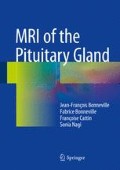Abstract
Pituitary centers which do not realize an immediate or 4-day postoperative MRI follow-up usually obtain an MRI at 3–6 months in search of a possible tumoral remnant. We recommend sagittal and coronal 3-mm thick T1WI and coronal 2-mm thick T2WI, ideally with a 3.0 T scanner. For easy comparison with the MRI follow-up to come, it is of uppermost importance to obtain coronal sequences with the same angulation, such as perpendicularly to the subcallosal plane (Fig. 27.1). In this way, recurrent tumors can be diagnosed and managed earlier (Fig. 27.2). An axial T2W 2-mm thick sequence is also useful if a small tumoral remnant is suspected at the posterior part of the cavernous sinus. If vasopressin storage has to be determined, an additional noncontrast axial T1W sequence is obtained. In our hands, contrast injection is frequently unnecessary and not routinely used. At 3 months postoperatively the Surgicel packing, if any, is not entirely resorbed; it will resorb later, by 6 months’ follow-up (Fig. 27.3). If tissue glue has been used, complete shrinkage of postoperative sellar mass can be delayed (Fig. 27.4). Fat graft, if implanted in the sella in the case of CSF fistula, shrinks partially, but will persist long term, as long as 10–25 years (Fig. 27.3). Fat graft can also migrate into the sphenoid sinus if the sellar floor has not been reconstructed. The rate of resorption of autologous fat graft remains largely unpredictable. In some rare circumstances, particularly if the patient has gained weight, an increased volume of the sellar fat graft can be observed (Fig. 27.5), as it is elsewhere in the body when fat is used for correction of soft tissue volume loss or for cosmetic reasons such as breast augmentation. T1 hyperintensity of the normal pituitary tissue is sometimes transiently observed in the few months after surgery (Fig. 27.6). We have hypothesized that this phenomenon reflects a transient hormonal synthesis increase of the small-volume residual pituitary. Most of the packing other than fat being resorbed at 6 months is sellar content consisting of normal pituitary residual tissue and/or tumoral remnant. We suggest that coronal high-resolution, 2-mm thick T2W sequences coupled with 3-mm thick noncontrast T1W sequences are the most informative to differentiate both, and that contrast-enhanced MRI can be frequently spared. At 6 months, final remodeling of the normal pituitary gland has occurred; it appears frequently as a homogeneous triangular or oval small mass in contact with the sellar floor and the medial wall of the cavernous sinus. On T2WI, the T2 signal of the tumoral remnant, if any, is nearly always more or less hyperintense if compared with that of the residual normal pituitary tissue. The pituitary stalk is tilted towards the normal pituitary. In case of doubt, i.e., normal pituitary versus tumoral remnant, sequential MRI rigorously performed with the same parameters and the same inclination will frequently demonstrate a slight increase volume of the remnant and no change in the normal pituitary gland remnant (Fig. 27.7). Nevertheless, some remnants can stay unchanged for years, but perfect reproducibility of sequential MRIs permits one to affirm this stability. Volumetry obtained from 3D images can also help, but is more complicated to implement. A vasopressin storage bright spot can increase in size in both eutopic and ectopic positions with time (Fig. 27.5a, b) or even reappear after complete disappearance. Axial T1W noncontrast fat-saturated sequence is of utmost importance to detect the tiniest T1-hyperintense spot after resumption of vasopressin synthesis and storage. Descent of the optic chiasm with a V-shaped appearance is constant after surgery of intra- and suprasellar masses. Fatty degeneration of the cortical bone of the sphenoid walls occurs as soon as 6 months postoperatively and increases for years thereafter. It is observed when the neurosurgeon has removed the sphenoidal sinus mucosa to avoid mucocele formation. Such bony changes can mimic, for instance, the osteoma of a meningioma of the planum sphenoidale (Fig. 27.8).
Access this chapter
Tax calculation will be finalised at checkout
Purchases are for personal use only
Further Reading
Anis KH, Sossa DE, Castillo M et al (2013) Intrasellar fat graft gains weight with the patient. Neuroradiol J 26:301–303
Bladowska J, Bednarek-Tupikowska G, Sokolska V et al (2010) MRI image characteristics of materials implanted at sellar region after transsphenoidal resection of pituitary tumours. Pol J Radiol 75(2):46–54
Nakasu Y, Itoh R, Nakasu S et al (1998) Postoperative sella: evaluation with fast spin echo T2-weighted high-resolution imaging. Neurosurgery 43:440–447
Author information
Authors and Affiliations
Rights and permissions
Copyright information
© 2016 Springer International Publishing Switzerland
About this chapter
Cite this chapter
Bonneville, JF. (2016). The Late Postoperative Sella. In: MRI of the Pituitary Gland. Springer, Cham. https://doi.org/10.1007/978-3-319-29043-0_27
Download citation
DOI: https://doi.org/10.1007/978-3-319-29043-0_27
Published:
Publisher Name: Springer, Cham
Print ISBN: 978-3-319-29041-6
Online ISBN: 978-3-319-29043-0
eBook Packages: MedicineMedicine (R0)

